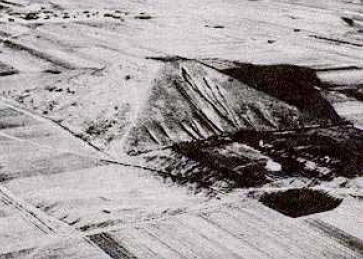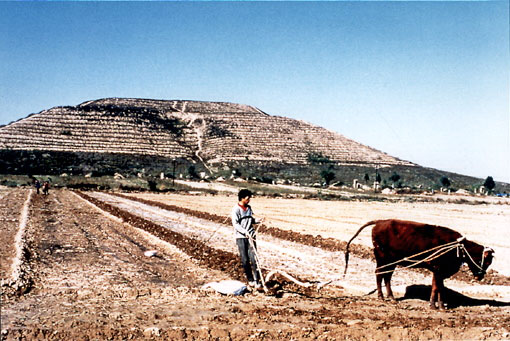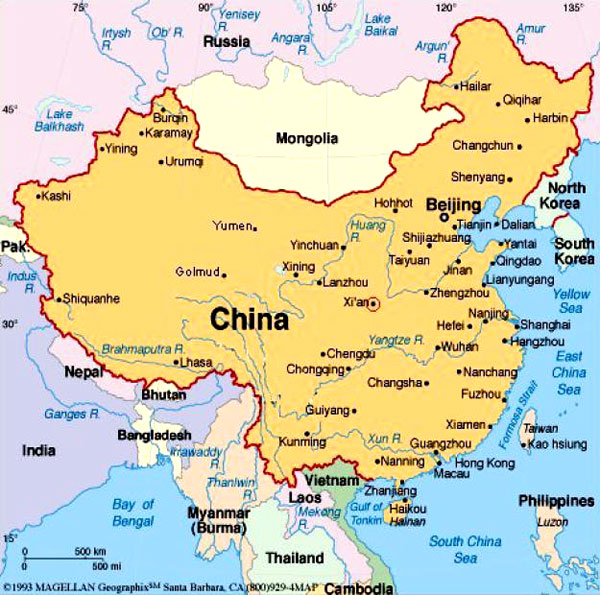|

by Philip Coppens
This article originally appeared in
Nexus New Times Magazine, in 1995
as well as Frontier Magazine 1.1
(1995)
from
PhilipCoppens Website
|
Despite speculation about
the existence of great pyramids in China, archaeologists
and bureaucrats have refused to consider even the
rumours about such structures. But recent pictorial
evidence proves that China’s pyramids are indeed real,
rivalling those of Egypt and Central America for their
age, size and significance. |
 In
1920, historian Henri Cordier wrote: In
1920, historian Henri Cordier wrote:
“China’s ancient past is denied both
to us and its population. Its grand past is slowly unveiled,
similar to how Egypt’s was revealed. Later on, one learned of
buildings, standing stones and other monuments that were not
mentioned by the Chinese historians (as part of their history).”
The largest country in the world was,
and is, largely there to be discovered. Though accepted as a great
civilization, its ancient treasures were barely known. One rumor
spoke about pyramids that could be found in desolate areas.
One such pyramid was photographed in 1947 by Col. Maurice Sheehan
from a DCS airplane. His story was printed in The New York Times in
March of the same year. Sheehan stated it rose to about 300 meters,
its sides 450 meters long. The next day, the Los Angeles Daily
Express ran Sheehan’s photograph. But a few days later, the
Associated Press received a letter from the authorities of the
province of Nankin, stating,
“the existence of such pyramids is
not backed up by evidence”.
That press release discredited Sheehan’s
story, as most authors and researchers believed Sheehan had
exaggerated. French author Patrick Ferryn stated:
“the photographs do not reveal any
markings that would allow us to measure the true dimensions. Its
height was probably an incorrect estimate. It is probably a
burial vault; it definitely looks like one.”
The 1950s and ‘60s had shown the world
the existence of many ‘ritual platforms’ and ‘artificial hills’ in
China, identical to pyramids in appearance except in terminology.
‘Pyramids’ have a magical appeal to many. Bruce Cathie also became
interested in the Chinese pyramids and wrote on the subject in The
Bridge to Infinity. Cathie reported that a member of the Chinese
Embassy had officially informed him there were no such things as
pyramids in the Shensi province:
“There are a few tumuli (burial
hills), but no pyramids. “
He knew nothing about the existence of
pyramids in China.

A letter from Chinese authorities, dated
1 November 1978, addressed to Cathie, stated the scientists had
learned that the so-called “pyramids” were burial tombs of emperors
of the Western Han dynasty.
“Records give a different version of
the emperors’ lives. As the graves have not been scientifically
analyzed and no markings were seen on the ground, it is
difficult to formulate conclusions.”
Still, there were historical records
that spoke of pyramids. The head of the Ts’in-family, Che Houang-ti
(the “Yellow Emperor”, the first to hold that title), changed
Chinese society dramatically. He built the Chinese Wall upon
listening to an oracle that prophesied a “barbarian” would attack
China. By 1974 the Emperor had again risen to popularity with the
discovery of his subterranean mausoleum. It contained no less than
6,000 terracotta warriors that were stored in combat mode and
believed to be intended as protection for the deceased Emperor in
his new existence. Historian Sseuma Ts’ien (135-85 BC) wrote that
this Emperor united China and destroyed all ancient writings as a
sign of the new era that was born. Some old books were apparently
saved, mainly in Taoist temples.
Che Houang-ti ordered 700,000 people to build him a pyramid at Lin-t’ong,
between Hnan and Si-ngan. The “Segalen mission”, a tour of China
that Segalen made in 1913, measured the pyramid’s height at 48
meters, encompassing five terraces. One side measured 350 meters,
120 meters longer than the side of Great Pyramid at Gizeh, Egypt.
With 1,960,000 cubic meters, it is fourth largest pyramid in the
world. The pyramid at Cholula, Mexico, and the two largest pyramids
at the Gizeh plateau precede it.
The Emperor possibly died in 210 BC. When his treasures were stored
in the pyramids, it was decided the workers would be sealed inside
the pyramid so no one could reveal where the pyramid was situated.
Plants were planted on its sides so the pyramid would eventually
take on the appearance of a natural hill. Sseuma Ts’ien wrote that
subterranean streams of lead engulfed the pyramid, the ceiling
depicted the sky, and the ground showed the expanse of the Empire.
Crossbows were aimed at trespassers—a burglar alarm which wasn’t
that successful, as General Hiang Yu was able to loot the pyramid in
207 BC.
The Segalen mission revealed more pyramids and tombs along the River
Wei. These were dated to the Han period, following that of Emperor
Che Houang-ti. As these were relatively recent pyramids, the
scientists did want to entertain the notion that these “burial
hills” might be “pyramids”, but, as mentioned, there were rumors of
taller and more ancient ones.

In 1912, Fred Meyer Schroder and
Oscar Maman traveled to Shensi. They not only dealt in
tobacco and candles but also supplied the Mongolians with weapons.
Their guide along the Chinese-Mongolian border was a monk, Bogdo
(“the holy one”), who told them they would soon stumble upon some
ancient pyramids. Though he himself had never seen them, he knew
some could be found around the old town of Sian-Fu.
“Mountains as high as the sky. They
are no ordinary burial vaults, though emperors or empresses
might be buried inside.”
Bogdo knew seven pyramids had been
discovered.
Schroder estimated the tallest one measured 300 meters high, its
sides 500 meters long. This would mean this pyramid was the largest
in the world, twice as large as the Great Pyramid at Gizeh. The
volume was 20 times as large as the Great Pyramid at Gizeh. Both
were built north-south/west-east.
“In the past, they were apparently
partly covered with stones, but those have disappeared. A few
stones lie at the bottom. It is an earthen pyramid, with giant
gullies on its sides. They were the reason why the stones
loosened and fell down. Its sides are now partially covered with
trees and shrubs. It almost looks a natural hill. We rode around
the pyramid, but did not discover any stairways or doors.”
When questioned, Bogdo believed it was
at least 5,000 years old. Their ancient records claimed that even
then the pyramids were “old”.
A US Air Force map detailing the area around the city of Xian, made
with the use of satellite photographs, shows at least 16 pyramids.
Xian, the ancient Sian-Fu, presently inhabited by more than six
million souls, is much older than Peking (Beijing). Once it was the
capital of the Empire: it was recognized as the umbilicus of China’s
civilization. Hartwig Hausdorf and his company of fellow travelers
landed at the new Xian airport and, driving to the city and their
hotel, saw one pyramid which stood along the road. It had been
discovered a few years earlier, when Xian’s airport was relocated
and a road to the city was engineered.

This pyramid would not even be the icing
on the cake for Hausdorf who was passionate about China’s ancient
history. In October 1994 he had climbed one pyramid and was able to
count 20 more pyramids, all lying in the immediate vicinity. Yet, in
March 1994 he had climbed that same pyramid and had seen only some
of those pyramids.
“It’s amazing how the weather in
March didn’t allow me to see those pyramids. In October it was
perfectly clear weather, and more revealed themselves.”
Hausdorf is not really flabbergasted
no-one knew about the existence of such pyramids:
“China has still a lot of
mysteries—even the local population quite often isn’t aware of
them. It’s a small miracle I received the go-ahead to enter some
‘no go’ areas. I was, in fact, the only one who was granted such
favors. I assume there are two reasons for this. I regularly
visit China with a group of tourists. In 1993, I became
acquainted with Chen Jianli, an avid researcher of his country’s
past. He assured me he would try and open a few doors inside the
Chinese Ministry of Tourism. In fact, in March 19941 was able to
visit some former ‘no go’ areas in the Shaanxi-province.
I passed around some copies of my
German book, Die Weisse Pyramide (The White Pyramid), to
the right people. I talked to archaeologists who at first denied
any pyramids existed, but finally recognized they did exist. I
was most pleased when the same people gave me further permission
to enter other ‘no go’ zones when I returned in October 1994. I
never expected any of this would happen to me. But it seems it
had to happen eventually. Following decades of rumor, someone
had to clear the picture.”
To detail his problems, in March 1994
Hausdorf met Professor Feng Haozhang (a prominent member of
Beijing’s academic circle), his assistant, Xie Duan Yu, and three
colleagues. At first they denied the pyramids’ existence. But when Hausdorf showed them three photos of three different pyramids, they
caved in. Hausdorf described his encounter:
“It was as if I had entered a hive.
The photographs I took in both March and October 1994 are the
proof that squelched five decades of rumor. Most scientists
denied the existence of pyramids in China. If any scientist
still clings to that, show him my photographs.”
Still, China will not give up all its
mysteries that easily. Several pyramids probably remain
undiscovered, their existence perhaps even unknown to the Chinese
scientists.
One mystery, however, definitely lingers on. At the end of the
Second World War, pilot James Gaussman had to adjust his course due
to engine problems. He tried to reach his base in Assam, India,
having dropped off supplies inside China. As he turned around one
mountain-top, a giant pyramid rose in the valley in front of him. It
was white, made out of metal or stone. According to Gaussman it
would have fitted perfectly in any fairy tale. A jewel-like stone
crowned its top.
“Though I wanted to set my plane on
the ground and investigate, there was no way I could land it on
that terrain.”
Gaussman flew three times around the
structure, photographing the pyramid with the same camera with which
he’d just photographed hostile troop movements. During his
debriefing in Assam, he told his intelligence officer the world
would be stunned when they learnt about that pyramid.
“There was nothing around it, just
this pyramid in the middle of nowhere. I think it’s extremely
ancient. Who built it? Why? What’s inside?”
Hausdorf and all in search of the “White
Pyramid” have never been able to rediscover it. Gaussman’s
photograph was developed and filed in a military archive where it
remained for the next 40 years until Australian Brian Crowley
published the photograph in his book, The Face on Mars.
Who built these pyramids? Bruce Cathie thinks he might know more.
Using his harmonics, he believes there is a mathematical connection
between the pyramids in China and the pyramids of Egypt. The number
16944 is present inside the Great Pyramid of Gizeh, he states, and
there are 16944 minutes of arc between the longitude of the Great
Pyramid at Gizeh and that of the tallest pyramid at Shensi. Their
dispersal along the river reminds him of the placement of the
pyramids in Egypt along the River Nile.
Cathie believes that it is evidence that
the pyramids were built by the same people. He also wonders whether
the decades-long silence surrounding the pyramids was to allow the
Chinese scientists to discover whether such a connection did indeed
exist.

Hartwig Hausdorf spoke to Professor
Wang Shiping who believes the pyramids have an astronomic alignment and
could be dated to 1,500-500 BC. Records of that time speak of the
emperors descending from heaven in flying dragons.
And so Hausdorf
has stumbled upon another fairy tale, of emperors descending from
heaven, which scientists think is impossible. Rest assured, Hausdorf
will also try to find out whether that ‘rumour’ is real or not.
|

 In
1920, historian Henri Cordier wrote:
In
1920, historian Henri Cordier wrote: 


